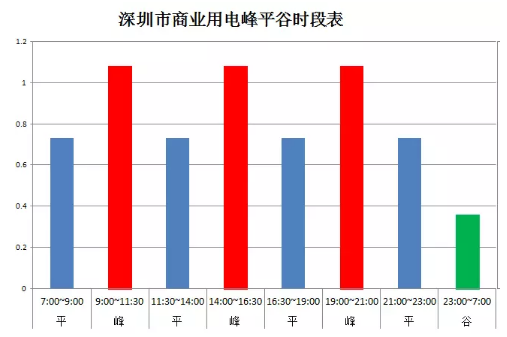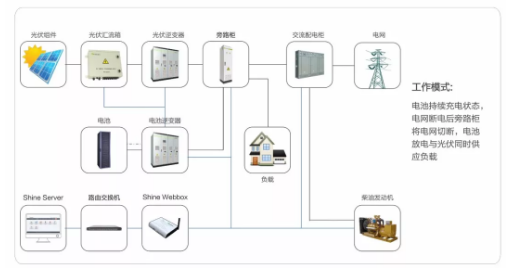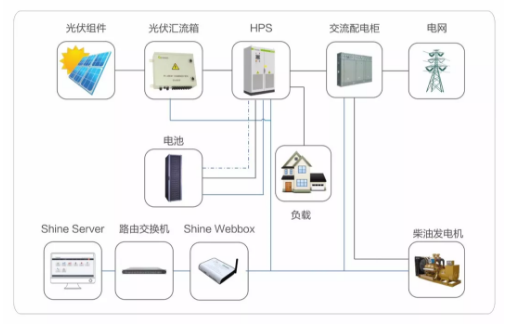How to rationally design industrial and commercial photovoltaic energy storage, without subsidies to achieve high returns?
With the increase in the cost of fossil energy such as coal and oil, the price of thermal power will be higher and higher, and the cost of solar energy will be lower and lower. However, the integration of a large amount of solar power into the power grid will bring about no small impact. The distributed solar power combined with the energy storage system can output at a constant power as required, overcoming the shortcomings of the photovoltaic system power instability.
Cultivating and expanding the clean energy industry and supporting the development of clean energy such as photovoltaic power generation are important contents of the energy production revolution and the consumer revolution. The country is unwavering in the direction of developing photovoltaics, and support for the photovoltaic industry is unwavering.
531 The three ministries and commissions issued documents. For the photovoltaic power generation projects with advanced technology, high development quality and no need for central financial subsidies, the state is liberalized. “Photovoltaic + energy storage†is one of the most reliable and promising possibilities, and the most promising distributed PV solution. In places with high electricity prices, large peak-to-valley spreads, and frequent power outages, reasonable design can achieve high returns even without state subsidies.
case study
Taking an industrial plant in Shenzhen as an example, we design a photovoltaic energy storage project. Shenzhen industrial and commercial electricity price is divided into three stages of Fengping Valley. As shown in the following figure, the peak electricity price is 1.08 yuan/degree, the flat value is 0.73 yuan, and the valley value is 0.36. yuan. The factory produces electricity from 8:00 am to 18:30 pm, with a power of about 120 kW, rest at 12:00-13:30, power is about 20 kW, and office power is 18:30-21:00, with a power of 40 kW. The electricity bill for daily use is as follows:
The flat section has a total of 6 hours, consumes 540 degrees, and the electricity cost is 394.2 yuan; the peak section has 5 hours and consumes 680 kWh. The electricity bill is 734.4 yuan. The valley does not consume electricity. There is a difference of about 10% in summer and winter. It will work overtime on Saturdays and more than 80 days of unproductive holidays in a year. The annual electricity bill is about 3 million. The owner of the project owns the factory, pays attention to environmental protection, and has idle funds to install photovoltaic power stations, which are used to offset electricity charges.

Design
According to the power consumption of the factory, the local climate in Shenzhen, the peak of light is about 6 hours, we design a photovoltaic and off-grid energy storage system, the components use 400 300W single crystal double-sided components, a total of 120kW, double-sided components The back can also generate electricity. Generally, the power generation is increased by more than 10%. It is expected to generate more than 400 kWh per day. When the light is best, it can send about 800 kWh. Use 20 blocks in series and 10 channels to form a confluence. Box, a total of 2 combiner boxes, the inverter uses HPS120kW and off-grid integrated machine, the output power is 132kVA, the battery uses 250 2V1000V lead carbon battery, the energy storage capacity is about 400 degrees.

The working states of the energy storage inverters are as follows:
1) When the electricity price is 23:00, the grid charges the battery with a current of 100A and charges it to 80%. When there is light in the morning, the PV array charges the battery pack until 9:00. If the battery is full, the power is about 400 degrees.
2) At the peak price of electricity: 9:00-11:30, the battery and components pass through the inverter, and the power is supplied to the load at a constant power of 100 kW, and consumes 250 kWh in 2.5 hours;
3) At the electricity price level of 11:30-14:00, the PV array charges the battery pack;
4) In the peak price range of 14:00-16:30, the battery and components pass through the inverter, and supply power to the load at a constant power of 100 kW, which consumes 250 kWh in 2.5 hours;
5) At the electricity price level: 16:30-19:00, the PV array charges the battery pack;
6) In the peak price of electricity price 19:00-21:00, if the battery power is still there, supply power to the load at a constant power of 20kW until the battery's power is 30%.
advanced technology
The system adopts the latest technology, double-sided single crystal module, two-way and off-grid energy storage inverter, lead carbon battery, advanced technology, high development quality, in line with the requirements of the National Energy Administration for photovoltaics, the state will strongly support.
1) Double-sided components: The battery technology used for the double-sided components mainly includes PE-based technology based on p-type silicon wafers, PERT technology based on n-type silicon wafers, and HIT technology based on heterojunction structures. In addition to receiving solar radiation on the front side, the back side of the double-sided assembly can also receive scattered light from the air, reflected light from the ground, and direct sunlight from the back every morning and evening. Therefore, the power output of the double-sided component has a gain of 10-30% compared to the single-sided component of the same power plant design.
2) Two-way and off-grid energy storage inverter: Guruwatt HPS series three-phase solar and off-grid inverter control integrated machine, using a new generation of all-digital control technology, pure sine wave output; solar controller and inverter Integrated in one, easy to use. The inverter is bidirectionally controlled for charging and discharging, and the charging and discharging time can be freely set and seamlessly switched from the off-grid state to provide an uninterruptible power supply to the load.
3) Lead carbon battery: Combining the technology of lead storage battery and super capacitor, it is a dual-function energy storage battery with both capacitance characteristics and battery characteristics. The charging current can reach 0.2C, and the discharge current can reach 0.4C. It is perfectly adapted to the optical storage system. The charging power is low for a long time, the discharge power is short and the time is short, the cycle life is high, and the 70% discharge depth cycle times exceed 4000 times. Life expectancy is more than 10 years, cost-effective, the price is slightly higher than the ordinary gel battery, which is one-third of the price of lithium batteries.

Investment income
First, the cost is calculated. After the introduction of the 531 new policy, equipment manufacturers such as components and inverters have dropped their prices. The raw materials and installation costs of 120kW photovoltaic power plants can be reduced to 4.8 yuan per watt, and EPC profits will also drop, accounting for 0.5 yuan per watt. In this way, the initial installation cost of the whole system is 636,000 yuan. The lead-carbon battery is the most expensive part of the system and the equipment with the shortest life. The current price has not been significantly reduced. The 250-cell 2V1000AH battery is about 450,000, with a total investment of 1.86 million yuan.
Recalculate the income, the average power generation is 400 degrees per day, 280 days for self-use, calculated at 1.08 yuan per kWh, the annual income is 121,000 yuan, the holiday balance is 85 days, and the desulfurization price is 0.45 yuan to the grid company. The total cost is 1.53 million yuan. There is also the difference between the peak and valley price difference, assuming that the battery charge and discharge efficiency is 85%, the electricity price peak charge 280 degrees, the electricity fee deducts 302.4 yuan, the electricity price valley charge 330 degrees, the cost is 118.8 yuan, the annual peak and valley spread profit It is 51,400 yuan. All income adds up to 187,700 yuan.
The model is set up as the factory owner has spare funds to invest by himself, and photovoltaic power generation is used to offset the electricity expenses, so the cost of the funds is not calculated, as well as various expenses such as taxes and rents.
According to the comprehensive calculation, the cost recovery period is 5.79 years. In less than 6 years, all the investment can be recovered, and nearly 15 years is pure income.
to sum up
Photovoltaic power generation combined with energy storage system not only expands the scope of application, but also brings more opportunities for the development of the photovoltaic industry, and the investment yield is still high.
1) The inverter can output at a constant power according to requirements, which overcomes the characteristics of unstable power of the photovoltaic module, can greatly increase the proportion of photovoltaic power generation in the power grid, and the inverter can also adjust the power factor and improve the quality of the power grid;
2) The electric energy is stored through the trough, the peak output power, and the peak power consumption of the power grid can be greatly reduced, and the peak price of the peak and valley electricity is used to create greater value for the user;
3) When the grid is out of power, the system can form an off-grid system to provide emergency power to the load.
The industrial and commercial roofs are complicated, and the power consumption of the factories varies widely. Each project needs careful analysis and tailor-made to achieve better economic efficiency. Guruwatt has carefully designed the HPS series 30-150kW suitable for industrial and commercial energy storage. Two-way and off-grid energy storage inverter, PCS series 250-630kW two-way energy storage inverter, successfully applied in many places at home and abroad, the company's technical support engineers are experienced, designing optimal solutions for customers, promoting industrial and commercial distribution The arrival of the era of photovoltaic parity online.

Sanitary 3A Union Fittings are fabricated complying with DIN11851 standard. Consisting of a round Slotted Nut, a Weld liner and Weld Male, and a o-ring seal. Kaysen Steel offers DIN11851 sanitary union fittings assembling with different types, and customized fabrication is available. If you have any questions or requests, pls feel free to contact us!
Stainless Steel Sanitary DIN11851 Unions – Sanitary Unions:
 Size: 1/2″ - 6″ (DN10-DN150)
Size: 1/2″ - 6″ (DN10-DN150) Material: SS304, SS316L, EN 1.4301, EN 1.4404 etc.
Material: SS304, SS316L, EN 1.4301, EN 1.4404 etc. Standard: 3A, DIN11851, SMS, ISO, RTJ, IDF,etc.
Standard: 3A, DIN11851, SMS, ISO, RTJ, IDF,etc. Connection Type: Clamped, Welded
Connection Type: Clamped, Welded Sealing Gasket: Silicone, EPDM, PTFE, Buna-N etc.
Sealing Gasket: Silicone, EPDM, PTFE, Buna-N etc. Temp.: -30°C / -22°F up to +120°C/ +248°F
Temp.: -30°C / -22°F up to +120°C/ +248°F Application: Food, Petroleum, Dairy, Pharmacy, Beer, Beverage, Biotech, Cosmetics etc.
Application: Food, Petroleum, Dairy, Pharmacy, Beer, Beverage, Biotech, Cosmetics etc.3A Sanitary Union
3A Sanitary Union,3A Sanitary Blind Nut Unions,3A Sanitary Hexagon Nut Unions
Kaysen Steel Industry Co., Ltd. , https://www.chinasanitaryvalve.com